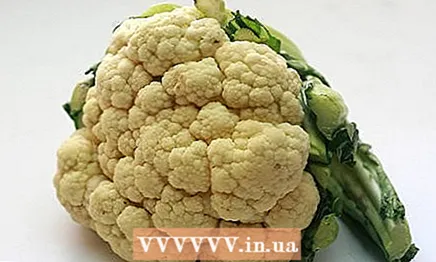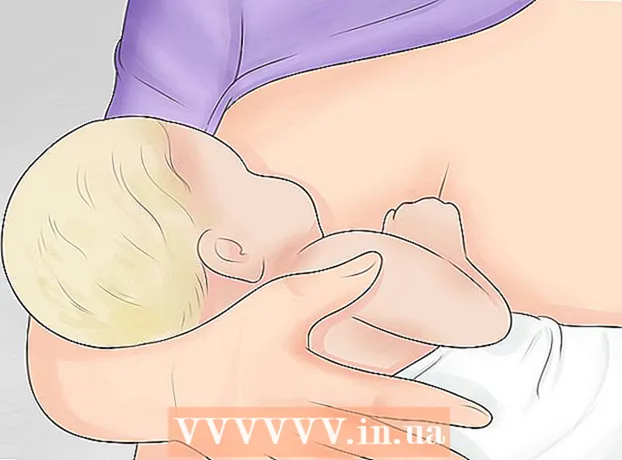Author:
Ellen Moore
Date Of Creation:
12 January 2021
Update Date:
1 July 2024

Content
- Steps
- Method 1 of 4: Preparation
- Method 2 of 4: Method One: Steam
- Method 3 of 4: Method Two: Bake
- Method 4 of 4: Method Three: Cauliflower with Sauce
- What do you need
Cauliflower inflorescences are small pieces that separate from a whole head of cabbage. Inflorescences are much easier to prepare than a whole head of cabbage. In any case, you may only need small portions. This article will show you how to cook cauliflower inflorescences.
Steps
Method 1 of 4: Preparation
 1 Buy a suitable cauliflower. It should be firm, white, free from spots or rot and with compact buds. The leaves should be fresh, healthy and green.
1 Buy a suitable cauliflower. It should be firm, white, free from spots or rot and with compact buds. The leaves should be fresh, healthy and green.  2 Remove the outer leaves of the cauliflower. If you want to use the leaves for your vegetable broth, then leave them and the parts of the cabbage that you usually throw away.
2 Remove the outer leaves of the cauliflower. If you want to use the leaves for your vegetable broth, then leave them and the parts of the cabbage that you usually throw away.  3 Turn the cauliflower trunk towards you.
3 Turn the cauliflower trunk towards you. 4 Cut it off. Save for vegetable broth if desired.
4 Cut it off. Save for vegetable broth if desired.  5 Prepare the inflorescences.
5 Prepare the inflorescences.- Hold the cauliflower in one hand.

- Keep the knife in your dominant hand. Take it at a 45º angle and cut off the small buds around the head of cabbage. Use circular motions. As you cut the inflorescences, you can remove the part of the stem that remains inside.

- Hold the cauliflower in one hand.
 6 Wash the inflorescences. Place them in a colander and rinse under running water.
6 Wash the inflorescences. Place them in a colander and rinse under running water.  7 Cut out any stains. Cauliflower often has harmless brown markings; just cut them out. Rinse or cut off dirt.
7 Cut out any stains. Cauliflower often has harmless brown markings; just cut them out. Rinse or cut off dirt.  8 Rate the inflorescences. Are they the right shape for your dish? If they are too large, cut them in half or even 4 pieces, depending on what you want.
8 Rate the inflorescences. Are they the right shape for your dish? If they are too large, cut them in half or even 4 pieces, depending on what you want.  9 Use as needed. Follow the steps below to make cauliflower.
9 Use as needed. Follow the steps below to make cauliflower.
Method 2 of 4: Method One: Steam
 1 Bring a large saucepan with a few liters of water to a boil. Add one glass of milk if desired. This will help preserve the white color of the cabbage.
1 Bring a large saucepan with a few liters of water to a boil. Add one glass of milk if desired. This will help preserve the white color of the cabbage. - Instead of milk, you can also add 1/2 lemon juice to the water, which also helps preserve the color of the cabbage.

- Instead of milk, you can also add 1/2 lemon juice to the water, which also helps preserve the color of the cabbage.
 2 Place a vegetable rack over the boiling water. Place it high enough so that the boiling water doesn't reach the cabbage.
2 Place a vegetable rack over the boiling water. Place it high enough so that the boiling water doesn't reach the cabbage.  3 Place cauliflower on a rack and reduce heat to medium. Cover the pot with a lid.
3 Place cauliflower on a rack and reduce heat to medium. Cover the pot with a lid.  4 Cook the cauliflower for 4-6 minutes, checking for doneness after 4 minutes. If the knife easily penetrates the stem, the cabbage is completely cooked. It is necessary that the cabbage is tender, but slightly crispy on the inside.
4 Cook the cauliflower for 4-6 minutes, checking for doneness after 4 minutes. If the knife easily penetrates the stem, the cabbage is completely cooked. It is necessary that the cabbage is tender, but slightly crispy on the inside. - If you want to steam a whole head of cabbage, you need 17-20 minutes.

- If you want to steam a whole head of cabbage, you need 17-20 minutes.
 5 Season with salt, pepper and serve!
5 Season with salt, pepper and serve!
Method 3 of 4: Method Two: Bake
 1 Preheat oven to 200 ° C and bring 7-8 liters of water to a boil.
1 Preheat oven to 200 ° C and bring 7-8 liters of water to a boil. 2 Cut the cauliflower into florets and simmer in boiling water for 3 minutes. Cooking means that you don't have to cook the cabbage to the end. Remove from pan and drain.
2 Cut the cauliflower into florets and simmer in boiling water for 3 minutes. Cooking means that you don't have to cook the cabbage to the end. Remove from pan and drain.  3 Place the cauliflower on a baking sheet or baking dish. Add the following:
3 Place the cauliflower on a baking sheet or baking dish. Add the following: - 2-3 cloves of coarsely minced garlic

- 1/2 lemon juice

- Olive oil to coat the cauliflower evenly

- Salt and pepper

- 2-3 cloves of coarsely minced garlic
 4 Cook the cauliflower in a preheated oven for 25-30 minutes.
4 Cook the cauliflower in a preheated oven for 25-30 minutes. 5 Remove the cauliflower from the oven and serve.
5 Remove the cauliflower from the oven and serve.- Sprinkle generously with Parmesan cheese before serving.

- Sprinkle generously with Parmesan cheese before serving.
Method 4 of 4: Method Three: Cauliflower with Sauce
 1 Pour 2.5 cm of water into a saucepan and bring to a boil.
1 Pour 2.5 cm of water into a saucepan and bring to a boil. 2 Place 1 large head of cauliflower in a saucepan.
2 Place 1 large head of cauliflower in a saucepan. 3 Cook, uncovered, for 5 minutes. Cover and cook for another 20 minutes, until the cabbage is tender.
3 Cook, uncovered, for 5 minutes. Cover and cook for another 20 minutes, until the cabbage is tender.  4 Drain the saucepan and measure out. You will need 1 glass of liquid. For every 1/2 cup liquid, add 1/2 teaspoon cornstarch and stir until smooth. Remove the cauliflower from the pot and add the liquid to it.
4 Drain the saucepan and measure out. You will need 1 glass of liquid. For every 1/2 cup liquid, add 1/2 teaspoon cornstarch and stir until smooth. Remove the cauliflower from the pot and add the liquid to it. - 5 Add to the liquid:
- 3 tablespoons butter

- 3 tablespoons lemon juice

- 1 tablespoon grated onion (finely chopped shallots will work as well)

- 1 teaspoon ground turmeric

- Salt and pepper to taste

- 3 tablespoons butter
 6 Cook, stirring occasionally, until the sauce thickens. Add 2 tablespoons of capers to the liquid, if desired.
6 Cook, stirring occasionally, until the sauce thickens. Add 2 tablespoons of capers to the liquid, if desired.  7 Pour the sauce over the cauliflower and garnish with finely chopped parsley.
7 Pour the sauce over the cauliflower and garnish with finely chopped parsley.
What do you need
- Durable work surface
- Colander or strainer
- Sharp knife for cutting vegetables
- Cutting board
- Cauliflower



